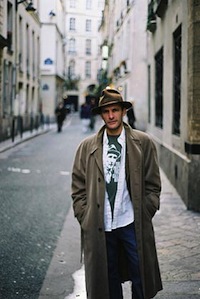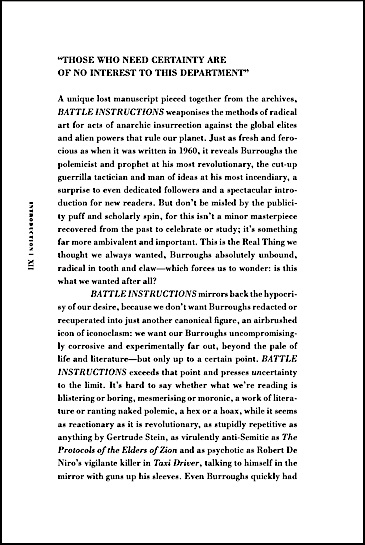‘This is Burroughs the self-styled revolutionary at his most historically explicit, the courageous whistle-blower in 1960 denouncing and exposing media magnates, business moguls, bankers, political leaders and scientists as part of a larger, deeper conspiracy at work behind the scenes of the mid-twentieth century.’
By Oliver Harris
BATTLE INSTRUCTIONS addresses particular individuals, which marks a key distinction from anything in Minutes to Go and The Exterminator before it or the Cut-Up Trilogy of The Soft Machine, Nova Express and The Ticket That Exploded that came after. Here, Burroughs doesn’t just lecture his enemies in general terms—“LISTEN ALL YOU BOARDS SYNDICATES GOVERNMENTS”—but openly names names—from “ROCKEFELLER LUCE GETTY” to “KHRUSHCHEV LENIN MARX EINSTEIN FREUD.”
Attacking American capitalism and imperialism in the shape of big oil and the news media, and Russian communism, science and psychoanalysis, Burroughs stands with the 99% (“WHAT AM I DOING OVER HERE WITH THE WORKERS???”) against the 1% (“WHY DONT I COME OVER WITH THE BOARD???”). Reneging on the class position of his birth, he performs the role of double-crossing defector from the ruling elites, “ONE OF THE GREAT RATS OF ALL TIME.. CALLED THE LAW ON ALL OF US. ALL RIGHT WILLY THE RAT TELL THE MARKS HOW IT WORKS.” This is Burroughs the self-styled revolutionary at his most historically explicit, the courageous whistle-blower denouncing and exposing media magnates, business moguls, bankers, political leaders and scientists as part of a larger, deeper conspiracy at work behind the scenes of the mid-twentieth century. And yet, rather than being dated by such unusual specificity, his vision continues to resonate for two particular reasons.

![Burroughs wearing his fedora. [Photo: Harriet Crowder]](https://www.artsjournal.com/herman/wp/wp-content/uploads/2015/02/Burroughs-fedora360jpg.jpg)
One is the balance Burroughs strikes between present-time realities and projected futures, which makes his polemical ground as much ante- as anti-anything. Or to put it another way, “ROCKEFELLER LUCE GETTY” is a shorthand Burroughs never expands upon: he gives no details of how Getty, named in 1957 the richest American alive by Luce’s Fortune magazine, had his “OILY HANDS” all over the Middle East, for example. That’s because such figures are for Burroughs themselves just more “EARTH PUPPETS,” not the Puppet Masters, to borrow the title of Robert Heinlein’s 1951 alien invasion novel. The higher-level powers and the future conflicts that are dramatized here are never completely in focus or fully formed but always remain shrouded in vagueness, like his later account of Luce’s media empire as “some sort of police organisation.” This was so even when—or rather, especially when—Burroughs sets out to explain his position, as in BATTLE INSTRUCTIONS’ opening and closing texts: “THIS IS THE SPACE AGE” thus begins with “POINTS TO CLARIFY” that clarify nothing, while the final mock interview, “OUT POSITION,” subtitled “WILLIAM BURROUGHS ANSWERS A FEW QUESTIONS,” fails to answer anything.
While Burroughs never theorised obscurity for self-evident reasons, he hinted at its strategic necessity in a letter to Mademoiselle magazine, who at the start of the year had published an amusingly cryptic piece of his imagining the 1960s: “I regret that you find my prophetic mutterings incomprehensible but isn’t it just a shade unreasonable to expect a road map of the next decade to be comprehensible in terms of present conditions?” The phrase “prophetic mutterings” originates in Naked Lunch and aligns Burroughs’ elusive futurology with the drug-induced visions of an Amazonian brujo, to insist on realities that cannot be reduced to familiar known terms. This is the second reason why Burroughs’ vision doesn’t date: unprecedented historical changes can only be represented and therefore grasped at all from an alien point of view and a new, enigmatic language, and he recognised 1960 as a turning point in the history of global capitalism without parallel, forecasting “an UNIMAGINABLE DISASTER” for the world and our species: “HUMAN CREATURES. LOOK! LOOK AT YOUR PLANET.”
Since the mid-1950s, Burroughs had been warning how technology might eliminate “the disturbing factor” of imaginative spontaneity so that human “behaviour can be controlled and predicted by the scientific methods that have proved so useful in the physical sciences.”
Against the ecologically catastrophic “GREEN DEAL,” which appears here for the first time before returning in Nova Express, Burroughs demands an end to “BUSINESS. AS USUAL,” and it’s a grim irony that his terms are being repeated 60 years later, by the Swedish environmental activist Greta Thunberg, word for word (“Today’s business as usual is turning into a crime against humanity”). Burroughs’ front line of attack, however, was not fossil fuels (Getty, Rockefeller), but media technology (Luce) and machine intelligence (Norbert Wiener). He saw, felt, and imagined the looming “UNIMAGINABLE DISASTER” with particular force because it was being enabled by rapid developments in computing power led by the very corporation that bore his family name: “MR BURROUGHS WHO MADE IT ALL POSSIBLE WITH HIS MACHINE […] THE MACHINE AGE FEEDS BACK FAVORABLE CONDITIONS FOR MACHINE MONOPOLY.”

— William S. Burroughs
Page design by Robert Schalinski.
Since the mid-1950s, Burroughs had been warning how technology might eliminate “the disturbing factor” of imaginative spontaneity so that human “behaviour can be controlled and predicted by the scientific methods that have proved so useful in the physical sciences.” Although his point of reference was the cybernetics of Wiener—named and quoted in “THE OCCUPATION”—this is near verbatim B.F. Skinner, who had advocated a “technology of behaviour” and dismissed human autonomy as a myth in Walden Two (1948). Since Skinner’s radical behaviourism aimed to reify the world and reduce the people in it to predictable data, to things (“NOW FOR GODS SAKE DONT LET THAT COCA COLA THING OUT…—… THING IS RIGHT”), it’s no surprise that it has informed the “prediction imperative” that drives the internet algorithms of Surveillance Capitalism. When Shoshana Zuboff describes how Google’s targeted advertising “revealed new capabilitie to infer and deduce the thoughts, feelings, intentions and interests of individuals,” she echoes with uncanny precision the formula of “biocontrol” cited by Burrough in Naked Lunch and The Exterminator, repeated here in “THE OCCUPATION” section: “WORD LINES CONTROL YOUR ‘THOUGHTS FEELINGS AND APPARENT SENSORY IMPRESSIONS.’”
Burroughs grasped not only the means but the scope of control systems to determine reality, and the emerging power of prediction and subliminal messaging over brute force or propaganda. In BATTLE INSTRUCTIONS, the model of control shifts from an industrial or bureaucratic society to a fully commoditized market that creates a world of desires and needs through the news media (“Whose LIFE TIME Owns Dreams?”) and TRAK, “THE SEX AND DREAM UTILITIES CONTROL BOARD.” TRAK is his vision of a total corpora- tion, one that incorporates the entire lives of its customers by selling the consumer to the product. Burroughs anticipates here not only the unprecedented asymmetrical power of 21st-century computerised mega-corporations that daily penetrate to the depths of our unconscious in order to monetize our experience, but also the totalising world-view that makes capitalism appear the only imaginable world, objectively true and perpetually necessary, rather than a masquerade of cataclysmic market interests: “‘IMMUTABLE REALITY OF THE UNIVERSE.’ TRAK UNIVERSE.”
This excerpt from Oliver Harris’s introduction to ‘Battle Instructions’ is © 2020 by Moloko.

